Let’s enter the world of the Scaly-Breasted Munia, a charming passerine bird renowned for its intricate plumage and lively demeanor. In this exploration, we journeyed to unravel the mysteries surrounding this delightful species.
The Scaly-Breasted Munia, scientifically known as Lonchura punctulata, captivates bird enthusiasts with its distinctive scaly patterned plumage and cheerful chirps.
Native to South and Southeast Asia, this small finch-like bird inhabits various habitats, from grasslands and agricultural areas to urban gardens and scrublands. Want to learn more about this bird?
Join us as we delve into the unique characteristics, behaviors, and habitat preferences of the Scaly-Breasted Munia.
Through this journey, we aim to gain a deeper understanding of this charming bird’s role in its ecosystems and the importance of conserving its natural habitats for future generations.
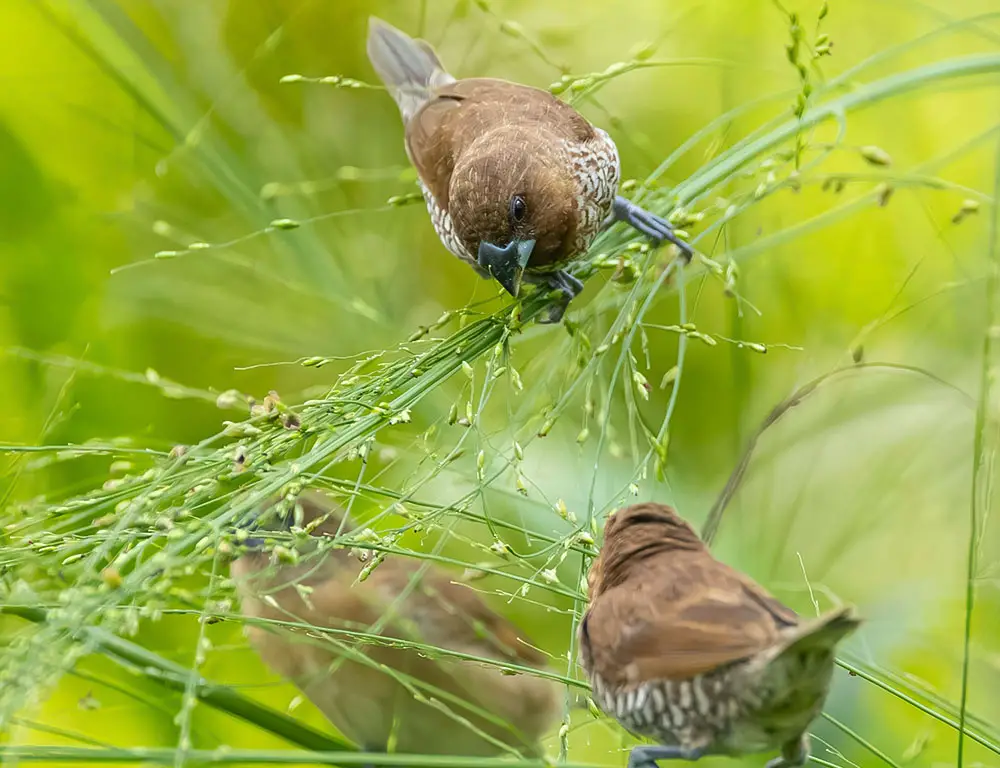
Fascinating Characteristics of the Scaly-Breasted Munia
Unravel the unique features and habits of the Scaly-Breasted Munia, a charming bird with distinct identifying characteristics that set it apart in the avian world.
Scaly Plumage
The Scaly-Breasted Munia boasts an adult plumage of deep, rich brown adorning its upperparts, head, and chest, contrasted by a striking pattern of scaly black feather edges on a white underbelly.
Juveniles exhibit a simpler appearance in plain brown and tan, distinguished by their petite stature and prominent black bill.
Small Size
It is a small bird, typically measuring around 10 to 11 centimeters in length. Its compact size and rounded body shape contribute to its adorable appearance.
Conical Bill
The Scaly-Breasted Munia has a short, conical bill adapted for seed-eating. This bill shape allows it to efficiently crack open and consume various seeds and grains, its primary food source.
Social Behavior
These munias are highly social birds. They are often found in small flocks or larger gatherings, especially during the non-breeding season. They engage in various social interactions, including foraging together and vocalizing.
These delightful birds are also known for their agility and acrobatic skills, mainly when foraging for food. They can often be seen clinging to grass stems or swaying on thin branches while extracting seeds, showcasing their remarkable talent.
Distinctive Call
The Scaly-Breasted Munia has a distinct call, often described as a series of high-pitched chirps or tinkling notes. This vocalization is used for communication within flocks and may serve to maintain group cohesion.
Foraging
Scaly-breasted munias are primarily seed-eaters, feeding on a variety of grass seeds, millets, and grains. They forage on the ground or in low vegetation, using their bill to extract seeds from seed heads or scatter them on the ground.
Pairing
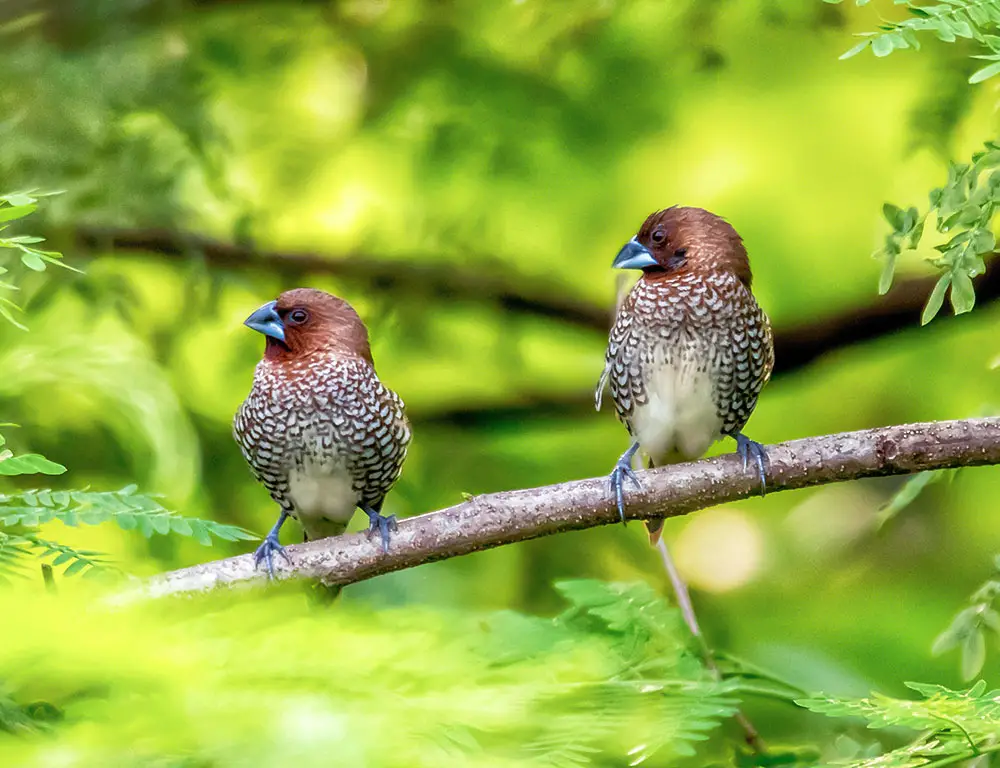
During the breeding season, pairs of Scaly-Breasted Munias build cup-shaped nests using grass, twigs, and other plant materials. These nests are typically located in shrubs or low trees and may be lined with softer materials for added insulation.
Habitat
Scaly-breasted munias are often spotted in open grasslands, agricultural fields, and even urban areas, where they thrive amid human habitation. Their adaptable nature allows them to exploit various habitats, from rice paddies and scrublands to parks and gardens.
Taxonomy of the Scaly-Breasted Munia
| Taxonomy Level | Classification |
| Kingdom | Animalia |
| Phylum | Chordata |
| Class | Aves |
| Order | Passeriformes |
| Family | Estrildidae |
| Genus | Lonchura |
| Species | Lonchura punctulata |
Distribution of the Scaly-Breasted Munia
The Scaly-Breasted Munia is widely distributed across South and Southeast Asia, including India, Bangladesh, Myanmar, Thailand, Indonesia, and the Philippines.
It occupies various habitats, from grasslands and agricultural fields to urban areas and gardens.
Food Habits
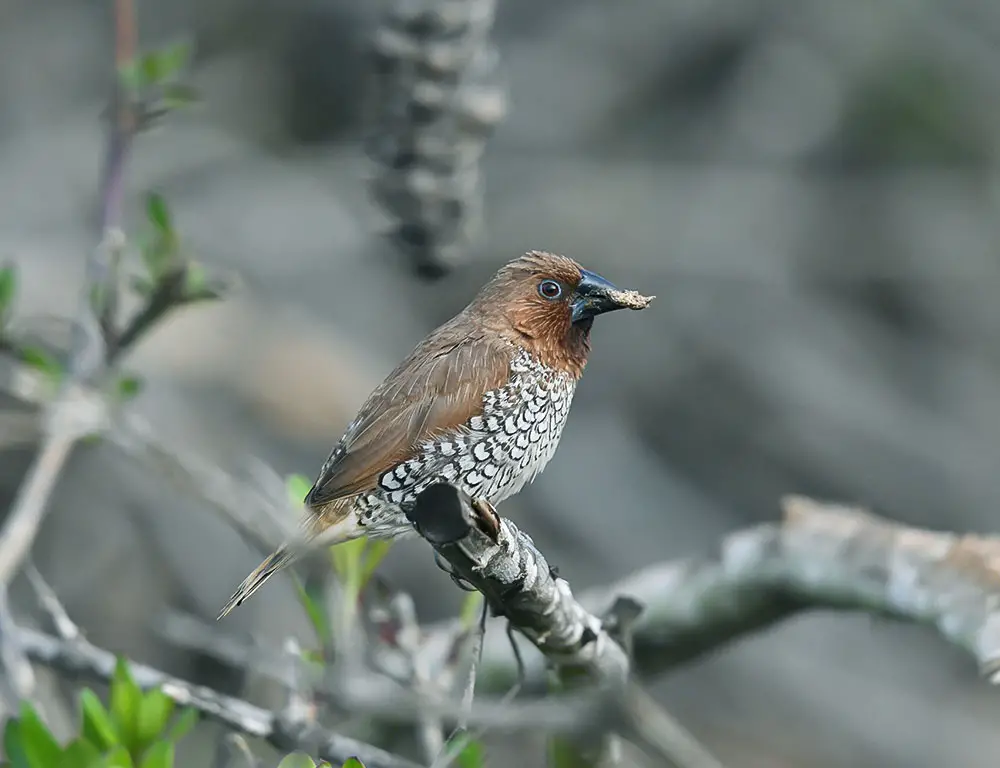
Scaly-breasted munias are primarily granivorous, feeding on diverse seeds and grains. Their diet includes grass seeds, millets, rice grains, and various cultivated crops.
They forage on the ground and in vegetation, using their conical bills to crack open seeds and extract the nutritious kernels.
Scaly-Breasted Munia Nesting
| Nesting Habit | Description |
| Nest Location | Scaly-Breasted Munias build cup-shaped nests using grass, twigs, and other plant materials. Nests are typically located in shrubs, bushes, or low trees, protecting from predators and the elements. |
| Nest Structure | The nests are constructed with a foundation of twigs and grass, lined with softer materials such as feathers or hair. The female lays a clutch of eggs, and both parents take turns incubating them until they hatch. |
Breeding Habits of the Scaly-Breasted Munia
Scaly-Breasted Munias breed throughout the year, with peak breeding activity often coinciding with periods of abundant food availability.
During the breeding season, males engage in courtship displays to attract females. Once pair bonds are formed, females lay a clutch of eggs, and both parents participate in incubating the eggs and caring for the young.
Diseases and Treatments
Scaly-Breasted Munias may be susceptible to various avian diseases and parasites, including avian pox, respiratory infections, and external parasites like mites and lice.
Treatment options include veterinary care, maintaining clean and hygienic aviary conditions, and providing a balanced diet to boost immunity.
Migration Patterns
Investigate the migration patterns of Scaly-Breasted Munias in regions where they undertake seasonal movements. Analyze factors such as environmental cues, food availability, and breeding cycles that influence their migratory behavior and explore the importance of stopover sites along their migration routes.
Is the Scaly-Breasted Munia Endangered?
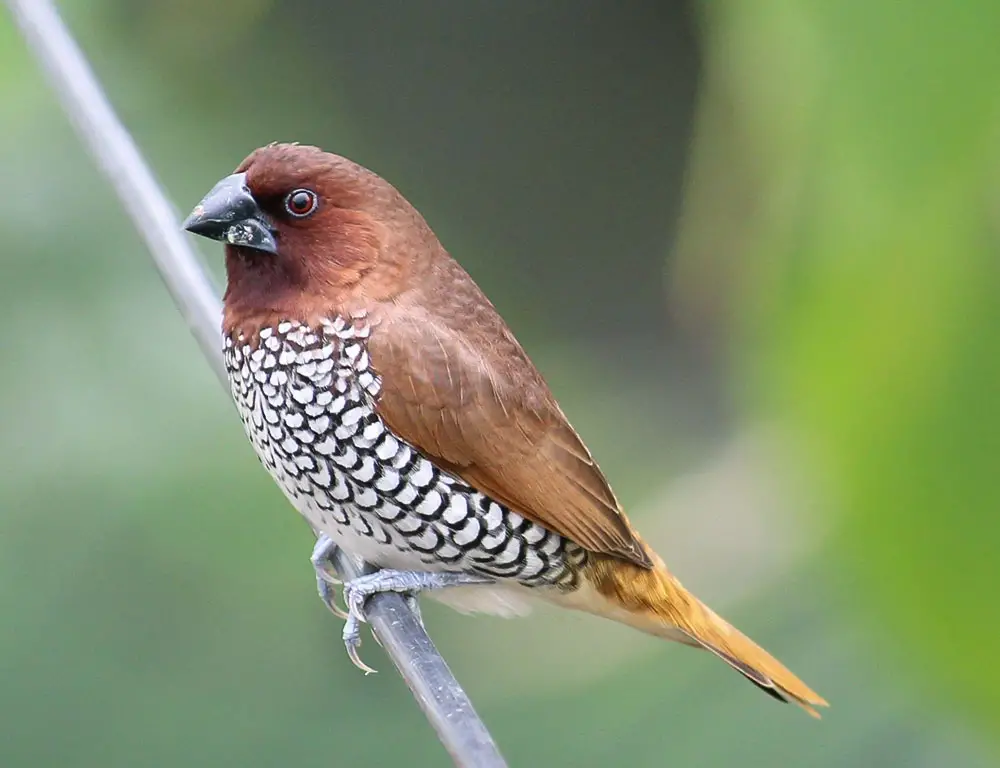
The Scaly-Breasted Munia is not classified as endangered or threatened globally. It is listed as a species of “Least Concern” by the International Union for Conservation of Nature (IUCN).
However, the conservation status of this species may vary regionally, and localized declines in populations have been reported in some areas.
Conservation Threats
Habitat loss and degradation due to urbanization, agricultural expansion, and deforestation pose significant threats to Scaly-Breasted Munia populations, particularly in densely populated regions where human activities encroach upon their natural habitats.
Additionally, introducing invasive species, competition for resources with other bird species, and indiscriminate hunting or trapping for the pet trade can further exacerbate population declines.
Conservation Efforts
Conservation efforts focused on habitat protection, restoration of degraded ecosystems, and raising awareness about preserving biodiversity are essential for safeguarding Scaly-Breasted Munia populations and ensuring their long-term survival.
Collaborative initiatives involving local communities, government agencies, and conservation organizations are critical for mitigating threats and implementing sustainable management practices to conserve this charming bird species.
5 Interesting Facts About the Scaly-Breasted Munia
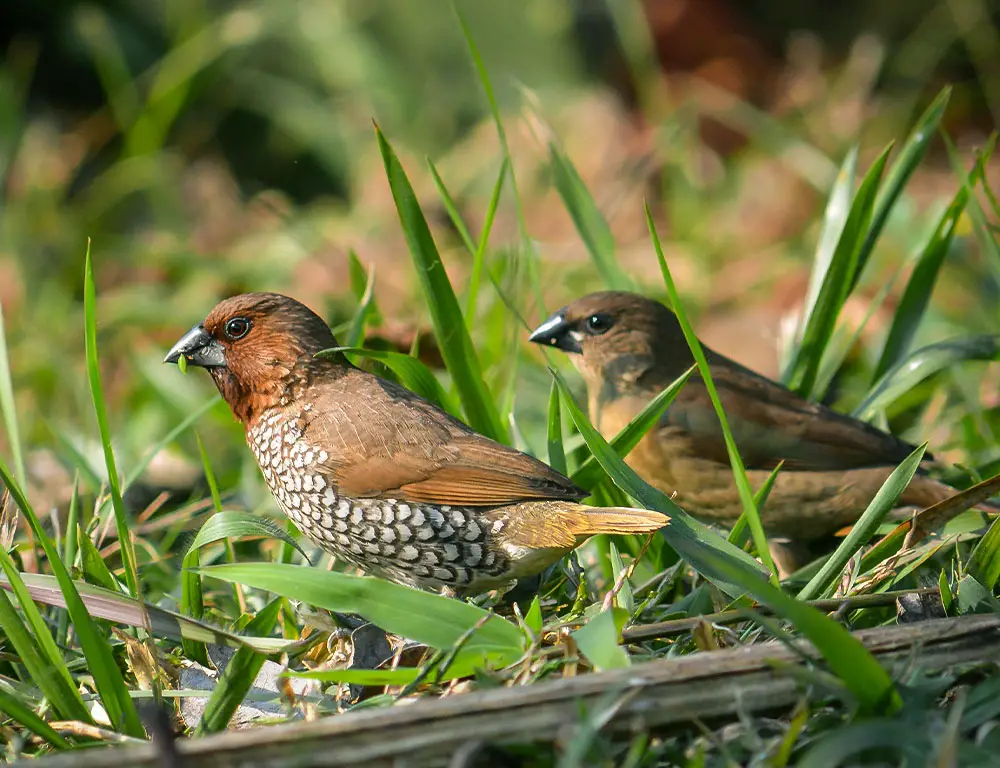
Discover six intriguing facts about the Scaly-Breasted Munia, highlighting its unique characteristics and fascinating behaviors.
1. Social Nesting
Scaly-Breasted Munias often nest in colonies, with multiple pairs building their cup-shaped nests close together. This social nesting behavior protects predators and facilitates communal defense of the nesting area.
2. Varied Vocalizations
Scaly-Breasted Munias are adept vocalizers, producing various calls and chirps. Their vocalizations include communication within flocks, mate attraction during the breeding season, and territorial defense against intruders.
3. Adaptability
These munias are highly adaptable birds, capable of thriving in a wide range of habitats, including grasslands, agricultural fields, urban parks, and gardens. Their ability to exploit diverse food sources and nesting sites contributes to their success in various environments.
4. Active Foragers
Scaly-Breasted Munias are active foragers, constantly looking for seeds, grains, and small insects.
They employ agile hopping and climbing movements to navigate through vegetation while searching for food, demonstrating their resourcefulness in obtaining nourishment.
5. Courtship Displays
During the breeding season, male Scaly-Breasted Munias engage in elaborate courtship displays to attract potential mates. These displays may involve fluffing their feathers, performing aerial maneuvers, and singing melodious songs to demonstrate their fitness and vigor.
Conclusion
The Scaly-Breasted Munia stands as a testament to our planet’s remarkable diversity of avian life. With its intricate plumage, cheerful demeanor, and adaptability to various habitats, this charming bird enriches the ecosystems it inhabits.
As we reflect on our journey through the world of the Scaly-Breasted Munia, we are reminded of the importance of preserving biodiversity and protecting the natural habitats that sustain these beautiful creatures.
By fostering conservation efforts and promoting awareness about the value of all species, we can ensure that the Scaly-Breasted Munia continues to grace our skies with its presence for generations to come.
Let us cherish and safeguard the intricate tapestry of life that includes the Scaly-Breasted Munia and countless other species to benefit our planet and all its inhabitants.